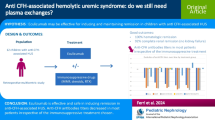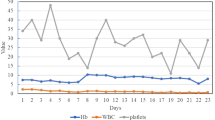Abstract
To assess response to cyclosporine A, and/or corticosteroids, and possible factors influencing the response in adult patients with acquired pure red cell aplasia (PRCA). Clinical data from 42 cases were retrospectively analyzed. These patients received cyclosporine A (CsA), and/or corticosteroids (CS), or other immunosuppressive agents on becoming refractory and relapse. Thirty-nine patients were evaluated. Remission induction therapy included CsA (n = 16), CS (n = 13), CsA in combination with CS (n = 6), or other immunosuppressive agents (n = 4). Initial response rates were 75.0, 46.2, 66.7 and 75.0%, respectively (P = 0.456). Cumulative response rates in patients who received CsA, CS, CsA in combination with CS, or other immunosuppressive agents were 69.6% (16/23), 50.0% (7/14), 71.4% (5/7), 42.9% (6/14), respectively (P = 0.376). Cumulative rates of CR were 26.1% (6/23), 28.6% (4/14), 57.1% (4/7), 14.3% (2/14), respectively (P = 0.284). In 27 refractory and relapsed PRCA patients, 11 of 17 patients (64.7%) achieved remission by CsA and/or CS regimen, while three of ten patients (30.0%) responded to other immunosuppressive agents (P = 0.120). CsA and/or CS were effective in treating PRCA. For patients with relapse or refractory PRCA, there were no satisfactory treatments if CsA and/or CS failed or were not administered.

Similar content being viewed by others
References
Dessypris EN, Lipton JM. Red cell aplasia. In: Wintrobe’s clinical hematology. 11th ed. Philadelphia: Lippincott Williams &Wilkins; 2004. p. 1421–1427.
Goldman L, Schafer AI. Aplastic anemia and related bone marrow failure states. In: Bagby GC, editor. Goldman’s cecil medicine. 24th ed. New York: Elsevier; 2011. p. 1083–90.
Fisch P, Handgretinger R, Schaefer HE. Pure red cell aplasia. Br J Haematol. 2000;111:1010–122.
Sawada K, Fujishima N, Hirokawa M. Acquired pure red cell aplasia: updated review of treatment. Br J Haematol. 2008;142:505–14.
Marmont AM. Therapy of pure red cell aplasia. Semin Hematol. 1991;28:285–97.
Lacy MQ, Kurtin PJ, Tefferi A. Pure red cell aplasia: association with large granular lymphocyte leukemia and the prognostic value of cytogenetic abnormalities. Blood. 1996;87:3000–6.
Mamiya S, Itoh T, Miura AB. Acquired pure red cell aplasia in Japan. Eur J Haematol. 1997;59:199–205.
Zecca M, Stefano P, Nobili B, Locatelli F. Anti-CD20 monoclonal antibody for the treatment of severe, immune-mediated, pure red cell aplasia and hemolytic anemia. Blood. 2001;97:3995–7.
Ghazal H. Successful treatment of pure red cell aplasia with rituximab in patients with chronic lymphocyticleukemia. Blood. 2002;99:1092–4.
Ru X, Liebman HA. Successful treatment of refractory pure red cell aplasia associated with lymphoproliferative disorders with the anti-CD52 monoclonal antibody alemtuzumab (Campath-1H). Br J Haematol. 2003;123:278–81.
Means RT Jr. Pure red cell aplasia. Blood. 2016;128:2504–9.
Sawada K, Hirokawa M, Fujishima N, Teramura M, Bessho M, Dan K, et al. Long-term outcome of patients with acquired primary idiopathic pure red cell aplasia receiving cyclosporine A. A nationwide cohort study in Japan for the PRCA Collaborative Study Group. Haematologica. 2007;92:1021–8.
Hirokawa M, Sawada K, Nakao S, Fujishima N, Nakao S, Urabe A, et al. Long-term response and outcome following immunosuppressive therapy in thymoma-associated pure red cell aplasia: a nationwide cohort study in Japan by the PRCA collaborative study group. Haematologica. 2008;93:27–33.
Dessypris EN. Pure red cell aplasia. Baltimore: Johns Hopkins University Press; 1988.
Charles RJ, Sabo KM, Kidd PG, Abkowitz JL. The pathophysiology of pure red cell aplasia: implications for therapy. Blood. 1996;87(11):4831–8.
Montane E, Ibanez L, Vidal X, Ballarin E, Puig R, Garcia N, et al. Epidemiology of aplastic anemia: a prospective multicenter study. Haematologica. 2008;93:518–23.
Kawahara S, Sasaki M, Isobe Y, Ando J, Noguchi M, Koike M, et al. Clinical analysis of 52 patients with granular lymphocyte proliferative disorder (GLPD) showed frequent anemia in indolent T-cell GLPD in Japan. Eur J Haematol. 2009;82:308–14.
Kwong YL, Au WY, Leung AY, Tse EW. T-cell large granu1ar lymphocyte leukemia: an Asian perspective. Ann Hematol. 2010;89(4):331–9.
Burks EJ, Loughran TP Jr. Pathogenesis of neutropenia in large granular lymphocyte leukemia and Felty syndrome. Blood Rev. 2006;20:245–66.
Sokol L, Loughran TP Jr. Large granular lymphocyte leukemia. Oncologist. 2006;11(3):263–73.
Qiu ZY, Fan L, Wang L, Qiao C, Wu YJ, Zhou JF, et al. STAT3 mutations are frequent in T-cell large granular lymphocytic leukemia with pure red cell aplasia. J Hematol Oncol. 2013;6:82.
Kawano N, Nagahiro Y, Yoshida S, Yamashita K, Himeji D, Uezono S, et al. Clinical characteristics and outcomes of 11 patients with pure red cell aplasia at a single institution over a 13-year period. Intern Med. 2013;52:2025–30.
Fujishima N, Sawada K, Hirokawa M, Oshimi K, Sugimoto K, Matsuda A, et al. Long-term responses and outcomes following immunosuppressive therapy in large granular lymphocyte leukemia-associated pure red cell aplasia: a Nationwide Cohort Study in Japan for the PRCA Collaborative Study Group. Haematologica. 2008;93:1555–9.
Hirokawa M, Sawada K, Fujishima N, Teramura M, Bessho M, Dan K, et al. Long-term outcome of patients with acquired chronic pure red cell aplasia (PRCA) following immunosuppressive therapy: a final report of the nationwide cohort study in 2004/2006 by the Japan PRCA collaborative study group. Br J Haematol. 2015;169:879–86.
Author information
Authors and Affiliations
Corresponding author
Ethics declarations
Conflict of interest
The authors declare that they have no conflict of interest.
Informed consent
Informed consent was obtained from all individual participants included in the study.
About this article
Cite this article
Wu, X., Wang, S., Lu, X. et al. Response to cyclosporine A and corticosteroids in adult patients with acquired pure red cell aplasia: serial experience at a single center. Int J Hematol 108, 123–129 (2018). https://doi.org/10.1007/s12185-018-2446-y
Received:
Revised:
Accepted:
Published:
Issue Date:
DOI: https://doi.org/10.1007/s12185-018-2446-y




